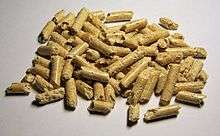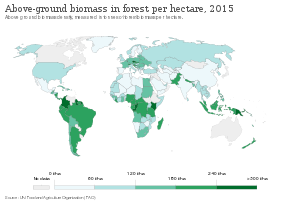Biomass
Biomass is plant or animal material used for energy production (electricity or heat), or in various industrial processes as raw substance for a range of products.[1] It can be purposely grown energy crops (e.g. miscanthus, switchgrass), wood or forest residues, waste from food crops (wheat straw, bagasse), horticulture (yard waste), food processing (corn cobs), animal farming (manure, rich in nitrogen and phosphorus), or human waste from sewage plants.[2]
Burning plant-derived biomass releases CO2, but it has still been classified as a renewable energy source in the EU and UN legal frameworks because photosynthesis cycles the CO2 back into new crops. In some cases, this recycling of CO2 from plants to atmosphere and back into plants can even be CO2 negative, as a relatively large portion of the CO2 is moved to the soil during each cycle.
Cofiring with biomass has increased in coal power plants, because it makes it possible to release less CO2 without the cost associated with building new infrastructure. Co-firing is not without issues however, often an upgrade of the biomass is most beneficial. Upgrading to higher grade fuels can be achieved by different methods, broadly classified as thermal, chemical, or biochemical (see below).
Biomass feedstocks
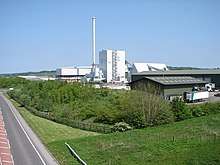
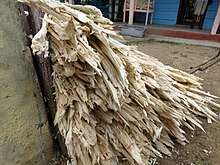
Historically, humans have harnessed biomass-derived energy since the time when people began burning wood fuel.[3] Even in 2019, biomass is the only source of fuel for domestic use in many developing countries. All biomass is biologically-produced matter based in carbon, hydrogen and oxygen. The estimated biomass production in the world is approximately 100 billion metric tons of carbon per year, about half in the ocean and half on land.[4]
Wood and residues from wood, for instance spruce, birch, eucalyptus, willow, oil palm, remains the largest biomass energy source today.[3] It is used directly as a fuel or processed into pellet fuel or other forms of fuels. Biomass also includes plant or animal matter that can be converted into fuel, fibers or industrial chemicals. There are numerous types of plants, including corn, switchgrass, miscanthus, hemp, sorghum, sugarcane, and bamboo.[5] The main waste energy feedstocks are wood waste, agricultural waste, municipal solid waste, manufacturing waste, and landfill gas. Sewage sludge is another source of biomass. There is ongoing research involving algae or algae-derived biomass.[6] Other biomass feedstocks are enzymes or bacteria from various sources, grown in cell cultures or hydroponics.[7][8]
Based on the source of biomass, biofuels are classified broadly into two major categories:
First-generation biofuels are derived from food sources, such as sugarcane and corn starch. Sugars present in this biomass are fermented to produce bioethanol, an alcohol fuel which serve as an additive to gasoline, or in a fuel cell to produce electricity.[9]
Second-generation biofuels utilize non-food-based biomass sources such as perennial energy crops (low input crops), and agricultural/municipal waste. There is huge potential for second generation biofuels but the resources are currently under-utilized.[10]
Biomass conversion
Thermal conversions
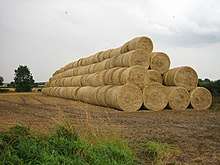
Thermal conversion processes use heat as the dominant mechanism to upgrade biomass into a better and more practical fuel. The basic alternatives are torrefaction, pyrolysis, and gasification, these are separated principally by the extent to which the chemical reactions involved are allowed to proceed (mainly controlled by the availability of oxygen and conversion temperature).[11]
There are other less common, more experimental or proprietary thermal processes that may offer benefits, such as hydrothermal upgrading.[12] Some have been developed for use on high moisture content biomass, including aqueous slurries, and allow them to be converted into more convenient forms.
Chemical conversion
A range of chemical processes may be used to convert biomass into other forms, such as to produce a fuel that is more practical to store, transport and use, or to exploit some property of the process itself. Many of these processes are based in large part on similar coal-based processes, such as the Fischer-Tropsch synthesis.[13] Biomass can be converted into multiple commodity chemicals.[14]
Biochemical conversion
As biomass is a natural material, many highly efficient biochemical processes have developed in nature to break down the molecules of which biomass is composed, and many of these biochemical conversion processes can be harnessed. In most cases, microorganisms are used to perform the conversion process: anaerobic digestion, fermentation, and composting.[15]
Glycoside hydrolases are the enzymes involved in the degradation of the major fraction of biomass, such as polysaccharides present in starch and lignocellulose. Thermostable variants are gaining increasing roles as catalysts in biorefining applications, since recalcitrant biomass often needs thermal treatment for more efficient degradation.[16]
Electrochemical conversion
Biomass can be directly converted to electrical energy via electrochemical (electrocatalytic) oxidation of the material. This can be performed directly in a direct carbon fuel cell,[17] direct liquid fuel cells such as direct ethanol fuel cell, a direct methanol fuel cell, a direct formic acid fuel cell, a L-ascorbic Acid Fuel Cell (vitamin C fuel cell),[18] and a microbial fuel cell.[19] The fuel can also be consumed indirectly via a fuel cell system containing a reformer which converts the biomass into a mixture of CO and H2 before it is consumed in the fuel cell.[20]
Environmental impact
On combustion, the carbon from biomass is released into the atmosphere as carbon dioxide (CO2). After a period of time ranging from a few months to decades, the CO2 produced from combustion is absorbed from the atmosphere by plants or trees. However, the carbon storage capacity of forests may be reduced overall if destructive forestry techniques are employed.[22][23][24][25]
All biomass crops sequester carbon. For example, soil organic carbon has been observed to be greater below switchgrass crops than under cultivated cropland, especially at depths below 30 cm (12 in).[26] For Miscanthus x giganteus, McCalmont et al. found accumulation rates ranging from 0.42 to 3.8 tonnes per hectare per year, [27] with a mean accumulation rate of 1.84 tonne (0.74 tonnes per acre per year),[28] or 20% of total harvested carbon per year.[29] The grass sequesters carbon in its continually increasing root biomass, together with carbon input from fallen leaves. Typically, perennial crops sequester more carbon than annual crops because the root buildup is allowed to continue undisturbed over many years. Also, perennial crops avoid the yearly tillage procedures (plowing, digging) associated with growing annual crops. Tilling induces soil aeration, which accelerates the soil carbon decomposition rate, by stimulating soil microbe populations. Also, tilling makes it easier for the oxygen (O) atoms in the atmosphere to attach to carbon (C) atoms in the soil, producing CO2.[30]
_life_cycle_emissions_for_Miscanthus_x_giganteus_and_SRC_Poplar.jpg)
.jpg)
The simple proposal that biomass is carbon-neutral put forward in the early 1990s has been superseded by the more nuanced proposal that for a particular bioenergy project to be carbon neutral, the total carbon sequestered by a bioenergy crop's root system must compensate for all the emissions from the related, aboveground bioenergy project. This includes any emissions caused by direct or indirect land use change. [31] Many first generation bioenergy projects are not carbon neutral given these demands. Some have even higher total GHG emissions than some fossil based alternatives.[32][33][34] Transport fuels might be worse than solid fuels in this regard.[35]
Some are carbon neutral or even negative, especially perennial crops. The amount of carbon sequestrated and the amount of GHG (greenhouse gases) emitted affect how the total GHG life cycle cost of a bioenergy project develops. Specifically, a GHG/carbon-negative life cycle is possible if the total below-ground carbon accumulation more than compensates for the above-ground total life-cycle GHG emissions. Biomass releases carbon dioxide gas that was absorbed during its growth cycle, indicating that released gas can be processed by photosynthetic methods.[36] Plants that are the source of the biomass may be a carbon-neutral energy source.[37]
Successful sequestration is dependent on planting sites, as the best soils for sequestration are those that are currently low in carbon. The assumption that annual cropland provides greater potential for soil carbon sequestration than grassland appears to be over‐simplistic, but there is an opportunity to improve predictions of soil carbon sequestration potential using the information on the initial soil carbon stock as a stronger predictor of ∆C [change in carbon amount] than prior land use.[38]
Forest-based biomass projects has received criticism for ineffective GHG mitigation from a number of environmental organizations, including Greenpeace (who in early 2000's were early supporters of biomass but changed their position by end of the decade[39]) and the Natural Resources Defense Council. Environmental groups also argue that it might take decades for the carbon released by burning biomass to be recaptured by new trees.[40][41] Biomass burning produces air pollution in the form of carbon monoxide, volatile organic compounds, particulates and other pollutants.[42][43][44] In 2009 a Swedish study of the giant brown haze that periodically covers large areas in South Asia determined that two thirds of it had been principally produced by residential cooking and agricultural burning, and one third by fossil-fuel burning.[45] The use of wood biomass as an industrial fuel has been shown to produce fewer particulates and other pollutants than the burning seen in wildfires or open field fires.[46]
As of 2020 biomass made 60% of European Union's renewable energy and received widespread criticism of its environmental impact, especially excessive land usage and excessive carbon emissions due to transporting biomass at large distances,[47] triggered EU review of its policy towards biomass.[48][49]
Regulatory requirement to use specific amount of biomass in EU created huge demand which is not being satisfied locally and is fulfilled by imports: for example, biomass from Poland is exported to German power plants, creating shortages in Poland,[50] so plants in Poland import it from distant locations such as Russia or Malaysia.[51] One power plant in Poland imports 7000 tons of wood each month from Komi Republic in Russia, 7000 km away.[52] UK power plants import over 6 millions of tons of wood from United States 7400 km away[47] as well as from Canada, Eastern Europe and Portugal, with 65% of the biomass being imported.[53] Contrary to popular belief, majority of the wood burned as biomass is not "wood residues" from sawmills etc (which only make 0.9%) but trees farmed specifically for this purpose.[53] Large-scale illegal logging is also a significant problem in Eastern Europe[54] and Russia.[55]
Carbon intensity of biomass can be higher than coal according to an UK 2014 study.[56]
Average surface power density of biomass is 0.08 W/m2 which is one of the lowest of all industrial energy sources.[57]
See also
| Part of a series on |
| Renewable energy |
|---|
 |
|
- Biochar
- Bioenergy
- Biofact (biology)
- Biofuel
- Biomass (ecology)
- Biomass gasification
- Biomass heating systems
- Biomass to liquid
- Bioproduct
- Biorefinery
- Carbon
- European Biomass Association
- Carbon footprint
- Cow dung
- Energy crop
- Energy forestry
- Firewood
- Microgeneration
- Microbial electrolysis cell generates hydrogen or methane
- Pellet fuel
- Permaculture
- Thermal mass
- Wood fuel (a traditional biomass fuel)
- Woodchips
- Renewable Energy Transition
References
- Ur-Rehman, S; Mushtaq, Z; Zahoor, T; Jamil, A; Murtaza, MA (2015). "Xylitol: a review on bioproduction, application, health benefits, and related safety issues". Critical Reviews in Food Science and Nutrition. 55 (11): 1514–28. doi:10.1080/10408398.2012.702288. PMID 24915309. S2CID 20359589.
- "Biomass - Energy Explained, Your Guide To Understanding Energy". U.S. Energy Information Administration. June 21, 2018.
- Retrieved on 2012-04-12.
- Field, C. B.; Behrenfeld, M. J.; Randerson, J. T.; Falkowski, P. (1998). "Primary Production of the Biosphere: Integrating Terrestrial and Oceanic Components" (PDF). Science (Submitted manuscript). 281 (5374): 237–240. Bibcode:1998Sci...281..237F. doi:10.1126/science.281.5374.237. PMID 9657713.
- Darby, Thomas. "What Is Biomass Renewable Energy". Real World Energy. Archived from the original on 2014-06-08. Retrieved 12 June 2014.
- Randor Radakovits; Robert E. Jinkerson; Al Darzins; Matthew C. Posewitz1 (2010). "Genetic Engineering of Algae for Enhanced Biofuel Production". Eukaryotic Cell. 9 (4): 486–501. doi:10.1128/EC.00364-09. PMC 2863401. PMID 20139239.
- "Biomass-to-Fuel Conversion (Princeton University USA)". Archived from the original on 2015-02-01. Retrieved 2015-02-13.
- The Nocera lab
- Martin, Marshall A. (1 November 2010). "First generation biofuels compete". New Biotechnology. 27 (5): 596–608. doi:10.1016/j.nbt.2010.06.010. PMID 20601265.
- Kosinkova, Jana; Doshi, Amar; Maire, Juliette; Ristovski, Zoran; Brown, Richard; Rainey, Thomas (September 2015). "Measuring the regional availability of biomass for biofuels and the potential for microalgae" (PDF). Renewable and Sustainable Energy Reviews. 49: 1271–1285. doi:10.1016/j.rser.2015.04.084.
- Akhtar, A., Krepl, V., & Ivanova, T. (2018). A Combined Overview of Combustion, Pyrolysis, and Gasification of Biomass. Energy & Fuels, 32(7), 7294–7318.
- Smith, Aidan Mark; Whittaker, Carly; Shield, Ian; Ross, Andrew Barry (2018). "The potential for production of high quality bio-coal from early harvested Miscanthus by hydrothermal carbonisation". Fuel. 220: 546–557. doi:10.1016/j.fuel.2018.01.143.
- Liu, G., E. D. Larson, R. H. Williams, T. G. Kreutz and X. Guo (2011). "Making fischer-tropsch fuels and electricity from coal and biomass: Performance and cost analysis." Energy & Fuels 25: 415–437.
- Conversion technologies Archived 2009-10-26 at the Wayback Machine. Biomassenergycentre.org.uk. Retrieved on 2012-02-28.
- "Biochemical Conversion of Biomass". BioEnergy Consult. 2014-05-29. Retrieved 2016-10-18.
- Linares-Pastén, J. A.; Andersson, M; Nordberg karlsson, E (2014). "Thermostable glycoside hydrolases in biorefinery technologies" (PDF). Current Biotechnology. 3 (1): 26–44. doi:10.2174/22115501113026660041.
- Munnings, C.; Kulkarni, A.; Giddey, S.; Badwal, S.P.S. (August 2014). "Biomass to power conversion in a direct carbon fuel cell". International Journal of Hydrogen Energy. 39 (23): 12377–12385. doi:10.1016/j.ijhydene.2014.03.255.
- Kim, Ye Eun (17 May 2011). "Surface Modifications of a Carbon Anode Catalyst by Control of Functional Groups for Vitamin C Fuel Cells". Electrocatalysis. 2 (3): 200–206. doi:10.1007/s12678-011-0055-0.
- Knight, Chris (2013). "Chapter 6 – Application of Microbial Fuel Cells to Power Sensor Networks for Ecological Monitoring". Wireless Sensor Networks and Ecological Monitoring. Smart Sensors, Measurement and Instrumentation. 3. pp. 151–178. doi:10.1007/978-3-642-36365-8_6. ISBN 978-3-642-36364-1.
- Badwal, Sukhvinder P. S.; Giddey, Sarbjit S.; Munnings, Christopher; Bhatt, Anand I.; Hollenkamp, Anthony F. (24 September 2014). "Emerging electrochemical energy conversion and storage technologies (open access)". Frontiers in Chemistry. 2: 79. Bibcode:2014FrCh....2...79B. doi:10.3389/fchem.2014.00079. PMC 4174133. PMID 25309898.
- "Above-ground biomass in forest per hectare". Our World in Data. Retrieved 15 February 2020.
- Prasad, Ram. "SUSTAINABLE FOREST MANAGEMENT FOR DRY FORESTS OF SOUTH ASIA". Food and Agriculture Organization of the United Nations. Retrieved 11 August 2010.
- "Treetrouble: Testimonies on the Negative Impact of Large-scale Tree Plantations prepared for the sixth Conference of the Parties of the Framework Convention on Climate Change". Friends of the Earth International. Archived from the original on 26 July 2011. Retrieved 11 August 2010.
- Laiho, Raija; Sanchez, Felipe; Tiarks, Allan; Dougherty, Phillip M.; Trettin, Carl C. "Impacts of intensive forestry on early rotation trends in site carbon pools in the southeastern US". United States Department of Agriculture. Retrieved 11 August 2010.
- "THE FINANCIAL AND INSTITUTIONAL FEASIBILITY OF SUSTAINABLE FOREST MANAGEMENT". Food and Agriculture Organization of the United Nations. Retrieved 11 August 2010.
- Soil Carbon under Switchgrass Stands and Cultivated Cropland (Interpretive Summary and Technical Abstract). USDA Agricultural Research Service, April 1, 2005
- McCalmont, Jon P.; Hastings, Astley; McNamara, Niall P.; Richter, Goetz M.; Robson, Paul; Donnison, Iain S.; Clifton-Brown, John (2017). "Environmental costs and benefits of growing Miscanthusfor bioenergy in the UK". GCB Bioenergy. 9 (3): 493. doi:10.1111/gcbb.12294. PMC 5340280. PMID 28331551.
...it seems likely that arable land converted to Miscanthus will sequester soil carbon; of the 14 comparisons, 11 showed overall increases in SOC over their total sample depths with suggested accumulation rates ranging from 0.42 to 3.8 Mg C ha-1 yr-1. Only three arable comparisons showed lower SOC stocks under Miscanthus, and these suggested insignificant losses between 0.1 and 0.26 Mg ha-1 yr-1.
- McCalmont, Jon P.; Hastings, Astley; McNamara, Niall P.; Richter, Goetz M.; Robson, Paul; Donnison, Iain S.; Clifton-Brown, John (2017). "Environmental costs and benefits of growing Miscanthusfor bioenergy in the UK". GCB Bioenergy. 9 (3): 496. doi:10.1111/gcbb.12294. PMC 5340280. PMID 28331551.
The correlation between plantation age and SOC can be seen in Fig. 6, [...] the trendline suggests a net accumulation rate of 1.84 Mg C ha-1 yr-1 with similar levels to grassland at equilibrium.
- Given the EU average yield of 18.8 tonnes dry matter per hectare per year (see Clifton-Brown, above), and 48% carbon content (see Kahle et al,, above).
- McCalmont, Jon P.; Hastings, Astley; McNamara, Niall P.; Richter, Goetz M.; Robson, Paul; Donnison, Iain S.; Clifton-Brown, John (2017). "Environmental costs and benefits of growing Miscanthusfor bioenergy in the UK". GCB Bioenergy. 9 (3): 493. doi:10.1111/gcbb.12294. PMC 5340280. PMID 28331551.
Any soil disturbance, such as ploughing and cultivation, is likely to result in short-term respiration losses of soil organic carbon, decomposed by stimulated soil microbe populations (Cheng, 2009; Kuzyakov, 2010). Annual disturbance under arable cropping repeats this year after year resulting in reduced SOC levels. Perennial agricultural systems, such as grassland, have time to replace their infrequent disturbance losses which can result in higher steady-state soil carbon contents (Gelfand et al., 2011; Zenone et al., 2013).
- Garcia, Daniel J.; You, Fengqi (2018). "Addressing global environmental impacts including land use change in life cycle optimization: Studies on biofuels". Journal of Cleaner Production. 182: 313–330. doi:10.1016/j.jclepro.2018.02.012.
- Whitaker, Jeanette; Field, John L.; Bernacchi, Carl J.; Cerri, Carlos E. P.; Ceulemans, Reinhart; Davies, Christian A.; Delucia, Evan H.; Donnison, Iain S.; McCalmont, Jon P.; Paustian, Keith; Rowe, Rebecca L.; Smith, Pete; Thornley, Patricia; McNamara, Niall P. (2018). "Consensus, uncertainties and challenges for perennial bioenergy crops and land use". GCB Bioenergy. 10 (3): 150–164. doi:10.1111/gcbb.12488. PMC 5815384. PMID 29497458.
The environmental costs and benefits of bioenergy have been the subject of significant debate, particularly for first‐generation biofuels produced from food (e.g. grain and oil seed). Studies have reported life‐cycle GHG savings ranging from an 86% reduction to a 93% increase in GHG emissions compared with fossil fuels (Searchinger et al., 2008; Davis et al., 2009; Liska et al., 2009; Whitaker et al., 2010). In addition, concerns have been raised that N2O emissions from biofuel feedstock cultivation could have been underestimated (Crutzen et al., 2008; Smith & Searchinger, 2012) and that expansion of feedstock cultivation on agricultural land might displace food production onto land with high carbon stocks or high conservation value (i.e. iLUC) creating a carbon debt which could take decades to repay (Fargione et al., 2008). Other studies have shown that direct nitrogen‐related emissions from annual crop feedstocks can be mitigated through optimized management practices (Davis et al., 2013) or that payback times are less significant than proposed (Mello et al., 2014). However, there are still significant concerns over the impacts of iLUC, despite policy developments aimed at reducing the risk of iLUC occurring (Ahlgren & Di Lucia, 2014; Del Grosso et al., 2014).
- Milner, Suzanne; Holland, Robert A.; Lovett, Andrew; Sunnenberg, Gilla; Hastings, Astley; Smith, Pete; Wang, Shifeng; Taylor, Gail (2016). "Potential impacts on ecosystem services of land use transitions to second-generation bioenergy crops in GB". GCB Bioenergy. 8 (2): 317–333. doi:10.1111/gcbb.12263. PMC 4974899. PMID 27547244.
The impact of growing bioenergy and biofuel feedstock crops has been of particular concern, with some suggesting the greenhouse gas (GHG) balance of food crops used for ethanol and biodiesel may be no better or worse than fossil fuels (Fargione et al., 2008; Searchinger et al., 2008). This is controversial, as the allocation of GHG emissions to the management and the use of coproducts can have a large effect on the total carbon footprint of resulting bioenergy products (Whitaker et al., 2010; Davis et al., 2013). The potential consequences of land use change (LUC) to bioenergy on GHG balance through food crop displacement or ‘indirect’ land use change (iLUC) are also an important consideration (Searchinger et al., 2008).
- McCalmont, Jon P.; Hastings, Astley; McNamara, Niall P.; Richter, Goetz M.; Robson, Paul; Donnison, Iain S.; Clifton-Brown, John (2017). "Environmental costs and benefits of growing Miscanthusfor bioenergy in the UK". GCB Bioenergy. 9 (3): 490. doi:10.1111/gcbb.12294. PMC 5340280. PMID 28331551.
While the initial premise regarding bioenergy was that carbon recently captured from the atmosphere into plants would deliver an immediate reduction in GHG emission from fossil fuel use, the reality proved less straightforward. Studies suggested that GHG emission from energy crop production and land-use change might outweigh any CO2 mitigation (Searchinger et al., 2008; Lange, 2011). Nitrous oxide (N2O) production, with its powerful global warming potential (GWP), could be a significant factor in offsetting CO2 gains (Crutzen et al., 2008) as well as possible acidification and eutrophication of the surrounding environment (Kim & Dale, 2005). However, not all biomass feedstocks are equal, and most studies critical of bioenergy production are concerned with biofuels produced from annual food crops at high fertilizer cost, sometimes using land cleared from natural ecosystems or in direct competition with food production (Naik et al., 2010). Dedicated perennial energy crops, produced on existing, lower grade, agricultural land, offer a sustainable alternative with significant savings in greenhouse gas emissions and soil carbon sequestration when produced with appropriate management (Crutzen et al., 2008; Hastings et al., 2008, 2012; Cherubini et al., 2009; Don- dini et al., 2009a; Don et al., 2012; Zatta et al., 2014; Rich- ter et al., 2015).
- Whitaker, Jeanette; Field, John L.; Bernacchi, Carl J.; Cerri, Carlos E. P.; Ceulemans, Reinhart; Davies, Christian A.; Delucia, Evan H.; Donnison, Iain S.; McCalmont, Jon P.; Paustian, Keith; Rowe, Rebecca L.; Smith, Pete; Thornley, Patricia; McNamara, Niall P. (2018). "Consensus, uncertainties and challenges for perennial bioenergy crops and land use". GCB Bioenergy. 10 (3): 150–164. doi:10.1111/gcbb.12488. PMC 5815384. PMID 29497458.
Significant reductions in GHG emissions have been demonstrated in many LCA studies across a range of bioenergy technologies and scales (Thornley et al., 2009, 2015). The most significant reductions have been noted for heat and power cases. However, some other studies (particularly on transport fuels) have indicated the opposite, that is that bioenergy systems can increase GHG emissions (Smith & Searchinger, 2012) or fail to achieve increasingly stringent GHG savings thresholds. A number of factors drive this variability in calculated savings, but we know that where significant reductions are not achieved or wide variability is reported there is often associated data uncertainty or variations in the LCA methodology applied (Rowe et al., 2011). For example, data uncertainty in soil carbon stock change following LUC has been shown to significantly influence the GHG intensity of biofuel production pathways (Fig. 3), whilst the shorter term radiative forcing impact of black carbon particles from the combustion of biomass and biofuels also represents significant data uncertainty (Bond et al., 2013).
- "Biomass Energy Basics". www.nrel.gov. Retrieved 2020-03-25.
- "Biomass and the environment - U.S. Energy Information Administration (EIA)". www.eia.gov. Retrieved 2020-04-11.
- Whitaker, Jeanette; Field, John L.; Bernacchi, Carl J.; Cerri, Carlos E. P.; Ceulemans, Reinhart; Davies, Christian A.; DeLucia, Evan H.; Donnison, Iain S.; McCalmont, Jon P.; Paustian, Keith; Rowe, Rebecca L.; Smith, Pete; Thornley, Patricia; McNamara, Niall P. (March 2018). "Consensus, uncertainties and challenges for perennial bioenergy crops and land use". GCB Bioenergy. 10 (3): 150–164. doi:10.1111/gcbb.12488. PMC 5815384. PMID 29497458.CS1 maint: ref=harv (link)
- "Battles over Biofuels in Europe: NGOs and the Politics of Markets". Sociological Research Online. doi:10.5153/sro.2192.
- "Dirtier than coal?" (PDF). Royal Society for the Protection of Birds. 2012. Retrieved 11 June 2020.
- McGrath, Matt (23 February 2017). "Most wood energy schemes are a 'disaster' for climate change". BBC News. Retrieved 11 June 2020.
- Eartha Jane Melzer (January 26, 2010). "Proposed biomass plant: Better than coal?". The Michigan Messenger. Archived from the original on 2010-02-05.
- Zhang, J.; Smith, K. R. (2007). "Household Air Pollution from Coal and Biomass Fuels in China: Measurements, Health Impacts, and Interventions". Environmental Health Perspectives. 115 (6): 848–855. doi:10.1289/ehp.9479. PMC 1892127. PMID 17589590.
- "Announcement". Archives of Virology. 130 (1–2): 225. 1993. doi:10.1007/BF01319012.
- Gustafsson, O.; Krusa, M.; Zencak, Z.; Sheesley, R. J.; Granat, L.; Engstrom, E.; Praveen, P. S.; Rao, P. S. P.; et al. (2009). "Brown Clouds over South Asia: Biomass or Fossil Fuel Combustion?". Science. 323 (5913): 495–8. Bibcode:2009Sci...323..495G. doi:10.1126/science.1164857. PMID 19164746.
- Springsteen, Bruce; Christofk, Tom; Eubanks, Steve; Mason, Tad; Clavin, Chris; Storey, Brett (2011). "Emission Reductions from Woody Biomass Waste for Energy as an Alternative to Open Burning". Journal of the Air & Waste Management Association. 61 (1): 63–8. doi:10.3155/1047-3289.61.1.63. PMID 21305889.
- "British Power Stations Are Burning Wood From US Forests – To Meet Renewables Target". IFLScience. Retrieved 2020-07-20.
- Simon, Frédéric (2020-07-14). "'Not all biomass is carbon neutral', industry admits". www.euractiv.com. Retrieved 2020-07-20.
- "COP25: EU officials say biomass burning policy to come under critical review". Mongabay Environmental News. 2019-12-16. Retrieved 2020-07-21.
- "Drewno z Polski trafia do niemieckich elektrowni? - Serwis informacyjny". www.cire.pl. Retrieved 2020-07-20.
- "Znowu fetor w Gdyni. Winna biomasa z portu?". trojmiasto.pl (in Polish). 2015-08-27. Retrieved 2020-07-20.
- "Centrozap sprzedaje w Polsce biomasę z Rosji - energetyka". wnp.pl (in Polish). Retrieved 2020-07-20.
- "| Biomass Basics". Retrieved 2020-07-21.
- Ribout, Benjamin (2020-06-03). "Illegal logging in Romania overwhelms authorities". www.euractiv.com. Retrieved 2020-07-21.
- "Была тайга, стала тундра: архангельские леса вырубают с невиданной скоростью". newizv.ru (in Russian). Retrieved 2020-07-21.
- "Life Cycle Impacts of Biomass Electricity in 2020" (PDF).
- van Zalk, John; Behrens, Paul (2018-12-01). "The spatial extent of renewable and non-renewable power generation: A review and meta-analysis of power densities and their application in the U.S." Energy Policy. 123: 83–91. doi:10.1016/j.enpol.2018.08.023. ISSN 0301-4215.
External links
| Look up biomass in Wiktionary, the free dictionary. |
| Wikimedia Commons has media related to Biomass. |
- Biomass interactive by PBL Netherlands Environmental Assessment Agency
- Forest, Nature and Biomass
- GA Mansoori, N Enayati, LB Agyarko (2016), Energy: Sources, Utilization, Legislation, Sustainability, Illinois as Model State, World Sci. Pub. Co., ISBN 978-981-4704-00-7
- Solid biomass EurObserv'ER barometer – 2012 PDF
